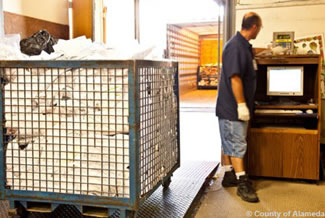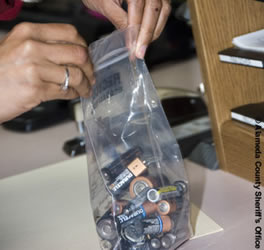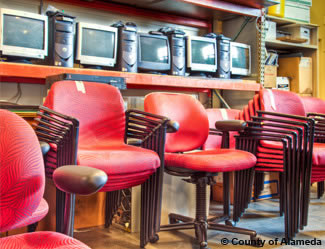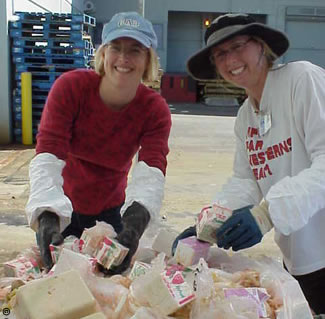
County employee weighs recycled paper. The County recycles more than 2 million pounds of paper per year.
At County Buildings
At the County, we look for every opportunity to reduce waste, reuse, recycle, and buy recycled-content products. In fact, our goal is to reduce the waste that goes to landfills by 75%. Our efforts reduce the amount of natural resources, water, energy, and chemicals used to manufacture products as well as the greenhouse gases produced in manufacturing and transporting these products.
Our multi-faceted program includes recycling at more than 150 County facilities, composting of landscaping waste, and a Property and Salvage department that helps the County to reuse furniture and equipment. These used items are also available for sale to the public so they won't go to the landfill. We look for ways to use less to begin with by converting paper processes to electronic. We also make sure that—whenever possible—the products we buy contain recycled content so we can help close the loop and create a market for the products we recycle.
Documents
- Waste Reduction & Recycling: Measure D (PDF - 69kb) *
- 75% Waste Reduction Resolution (PDF - 58kb) *
Related Links
- California Department of Resources Recycling and Recovery (CalRecycle)
- U.S. Resource Conservation and Recovery Act

The County makes it easy for employees to recycled used batteries, which are turned into steel.
Battery Recycling
Many of the things we use every day rely on batteries, yet batteries contain corrosive materials or heavy metals, such as mercury, cadmium, or lead. In California, it is now illegal to dispose of batteries in the trash. The General Services Agency provides a convenient recycling option for the batteries County employees generate through conducting County business. Employees can simply put used batteries into pre-labeled plastic bags and leave them in the outgoing inter-office mail system. Our County's messenger service then picks up the bags and takes them to our Property and Salvage department where they are sorted into three categories by battery type and shipped in bulk to Household Hazardous Waste. Our Household Hazardous Waste Department then sends batteries to accredited recycling facilities, which turn the used batteries into steel.

The Property & Salvage department reuses furniture and equipment and operates the recycling program at County facilities.
Property & Salvage
Reuse
Imagine the following scenario: An employee moves offices or gets an upgrade to a computer that helps him or her provide services to residents more quickly and effectively. What happens to his or her used office furniture or old computer? At the County, we don't believe in wasting anything that could be used again. Our Property and Salvage department collects used furniture and equipment and reuses them in other County facilities, donates them to schools or sells those items to the public. Only when all of these options are exhausted are items disposed of properly. We reuse and sell about 16,000 items per year.
How to Buy High-Quality Used Furniture and Equipment:
Location: 15800 Foothill Blvd, San Leandro, CA
Hours open to the public: 8:30-noon, 12:30-3:00 pm, Mon. - Fri.
Telephone Number: 510-667-7591
Recycling
The property and salvage department also operates the recycling program for County facilites. Property and Salvage saves more than $200,000 taxpayer dollars per year by recycling:
- Batteries—more than 2,400 pounds
- Electronic waste (computers, servers, copiers, printers, X-ray equipment etc.)—more than 49,000 pounds per year
- Paper—more than 1.6 million pounds per year
- Plastic—more than 5,800 lbs per year
- Scrap metal—more than 330,000 lbs per year
Related Links
- Public Surplus Web site
Lists of items for sale by public agencies.

Sustainability staff sort through trash as part of planning an effective waste reduction program.
Waste Audit
Sorting through trash may not sound like how you want to spend your work day, but a few years ago, that's exactly what we did. We knew that we needed to find out how much of what kinds of trash we produce so we could come up with an effective program to reduce the waste we generate. This—plus making sure that the recycling and waste services we were getting were cost-effective—was the goal of the County's 2004 Waste Audit. After hours and hours of examining waste bills, meeting with staff, and sorting through trash, the waste audit was a success. Not only did we get the information we needed to help plan for reducing waste, we also saved the County $100,000 per year by making sure that the services we were getting matched our needs and were cost-effective.

